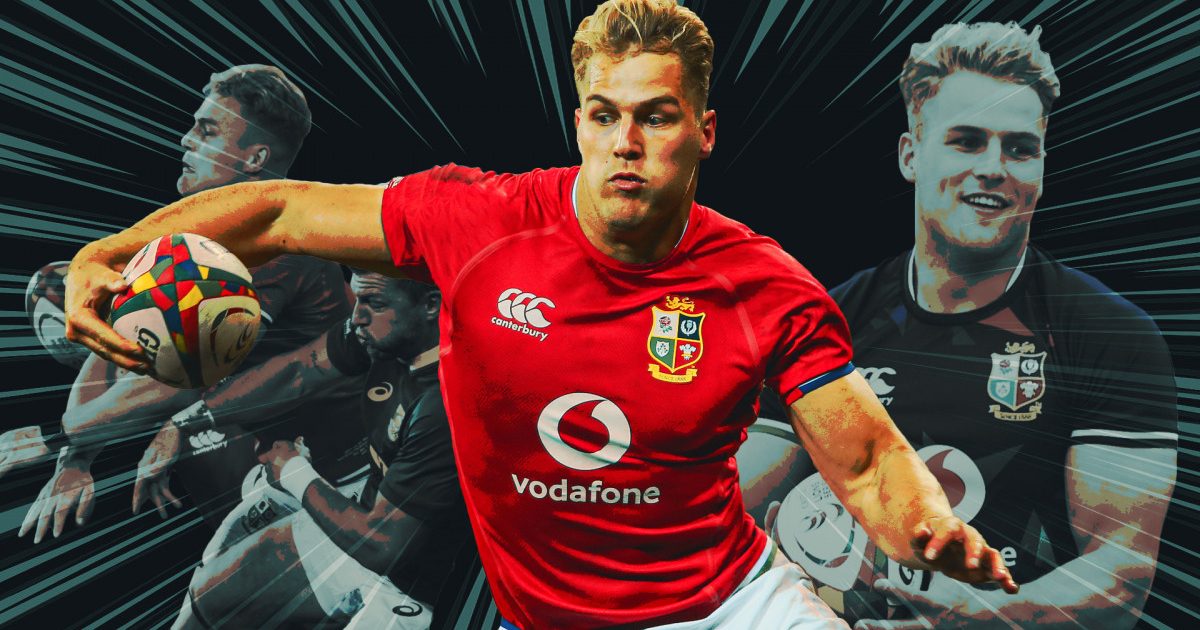For the third and final test with the Springboks, the Lions have largely returned to the backline that started their campaign against Japan back at Murrayfield, with Conor Murray the only change.
In comes Bundee Aki to resume his midfield partnership with Robbie Henshaw, while Liam Williams and Josh Adams return to the back three with Duhan van der Merwe, who retains his place on the left flank.
The South African-born wing has come under heat for retaining his place in the side after a test where he wasn’t heavily involved and received a yellow card for a foot trip on Cheslin Kolbe.
It hasn’t been the test series where Van der Merwe has received quality ball, or even half a chance, to smash through edge defences.
When Anthony Watson linked in from the opposite wing on a rare shift by the Lions with a three-on-one beginning to form a quarter way through the second test, Watson’s wobbly forward pass sailed a metre in front of Hogg and Van der Merwe into touch.
If Henshaw had looked outside when he made the line break on the stroke of halftime in the first test, he might have found Van der Merwe unmarked on the way for a Lions’ test try.
There have been moments, but they just haven’t gone the way of the Scottish international.
Despite his lack of involvement in attack, there is the ground zero level observation that he is simply the tallest guy in the backline – the man is 6’3 and built like a truck.
If the Lions are going to go to the air again, height is an asset to have and Van der Merwe has proven to be vitally important in the kick-chase game for the Lions despite not featuring in attack so far.
It’s not even a question, Van der Merwe has almost single-handedly flipped games for the visitors in the kick-chase game, particularly the first test.
Over the series, when the Lions have kicked a contestable with Van der Merwe as or in the kick-chase unit, the Springboks are 0/11 in the air.
That’s right, a zero per cent success rate when Van der Merwe has competed for the ball. That is simply incredible, and it is forcing the Springboks into huge momentum-swinging mistakes.
The Springboks were 0/6 in the first test and 0/5 in the second. The Lions could do worse than continue to hoist to the sky from the left side of the field as the Springboks haven’t caught a ball under pressure from him.
Against Van der Merwe in the air from Lions’ kicks, Willie le Roux is 0/4, Cheslin Kolbe is 0/3, Handre Pollard is 0/2, Jasper Wiese is 0/1, and Kwagga Smith is 0/1.
It is not easy to bring in the ball when competing with a 6’3 giant. Some of those contests have been in tandem with Robbie Henshaw, who also has been a disruptive force. Many of them have resulted in penalties, scrums and recovered possession for the Lions.
When they have overcooked the kick too far, Van der Merwe has been there to manhandle the catcher after the grab if the run is timed well.
In the first test, he forced two turnovers on Kwagga Smith with tackles in the backfield, a penalty and a knock-on, in the second half momentum swing off Ali Price’s box kicks.
He almost grabbed a runaway try when the ball rebounded off a double aerial challenge on Kolbe into his lap, if not for a touch by Henshaw first.
All the Lions’ success in the air in this series has come down the left hand side where Van der Merwe is chasing, while Anthony Watson on the opposite has had little positive impact. And that is simply why he must be picked in this game plan. It works with him chasing the kicks.
On the right side, the Springboks have caught just about everything against Watson and others chasing. Perhaps the Lions have figured this out, and reinstated Ali Price and his left foot box kick into the starting line-up for the third test.
When Jasper Wiese dropped the ball cold directly from the kick-off, he had one eye fixed on Van der Merwe charging at him as the gunner from the restart. It wasn’t even a contest, just a mental error.
In the second test, all three of the Lions’ back three were unreliable trying to diffuse the Springboks’ own kicks. Williams and Adams have been brought in to shore that up, but Van der Merwe has been too valuable in the chase game to discard.
Catching is one thing, securing the ball next is another. You need big bodies to compete with the likes of the Springbok loose forwards on the floor after a catch and tackle situation.
When Liam Williams takes a high ball and is tackled in the backfield, how will Josh Adams go trying to clean out a Springbok loose forward? Adams is a decent finisher but he is going to have his work cut out for him in the air and on the ground.
The breakdown battles are ruthless, and a powerful guy like Van der Merwe is handy when backs are required to clean or hold the fort.
Two penalties were conceded to the Springboks over the weekend when Stuart Hogg was tackled and Chris Harris and Robbie Henshaw were blown off the ball by Springboks flooding the ruck.
Pollard kicked one goal and fortunately for the Lions missed the other. Van der Merwe offers protection against these types of penalties with the ability to match it against loose forwards at rucks after kicks.
The thinking behind all these selections is surely to triple down on the aerial game, and some of them must be to shore up their aerial defence after the second test.
And Van der Merwe is crucial to that plan, at least when the Lions are hoisting it into the air.






























